- The BoC will probably hold its policy rate next week...
- ...after core measures softened alongside lower revisions...
- ...but risks to underlying inflation remain pointed higher...
- ...so don’t pull out the punch bowl just yet
- CDN CPI m/m NSA % // y/y %, September:
- Actual: -0.1 / 3.8
- Scotia: 0.2 / 4.1
- Consensus: 0.1 / 4.0
- Prior: 0.4 / 4.0
- Trimmed mean y/y %: 3.7 (prior 3.9)
- Weight median y/y %: 3.8 (prior 4.1)
Canadian core measures of inflation noticeably weakened in the latest readings including revisions that lowered prior estimates. Canada’s front-end is subsequently outperforming the US front-end with the latter buoyed by a relatively stronger than expected set of retail sales numbers.
The Bank of Canada has cover to skip next Wednesday when its MPR tome drops with a dull thud. I expect a hold at a 5% overnight rate with continued guidance that they “are prepared to increase the policy rate further if needed.”
To do anything less than that would violate what I think are ongoing upside risks to trend inflation into 2024. To strike out such a reference would also perversely ease financial conditions relative to what are still priced expectations for a further hiking bias. To pull out the pom poms could make the BoC look rather foolish if the first hint at a soft patch for underlying inflation reverses higher again in subsequent readings. To have faith that this is the beginning of a trend their models have hoped to see for so long would place grossly excessive faith in those models that have not worked well to date. So for now, take the good news, but continue to tread very carefully.
Key is the fact that the high frequency core measures cooled sharply and with downward revisions that I’ll come back to in a moment. Trimmed mean CPI landed at 2.4% m/m at a seasonally adjusted and annualized rate. Weighted median was up by 1.75% m/m SAAR. The 2.1% average is the lowest since August 2022 (chart 1).
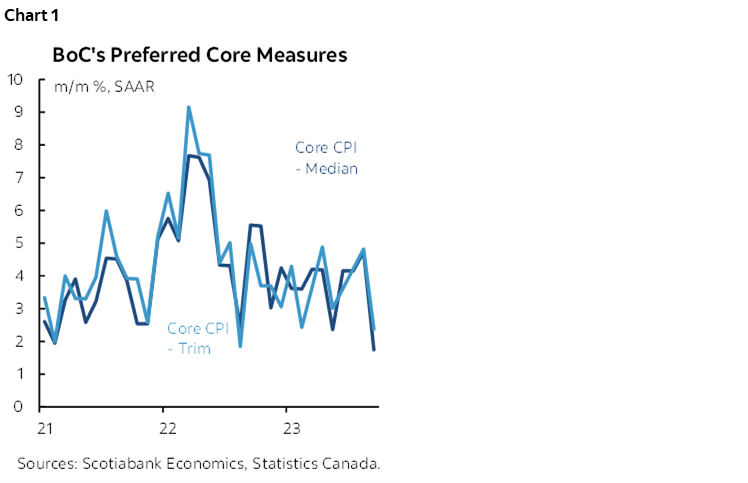
Still, the 3-month moving average including revisions is at 3% that, while the lowest since November 2021, remains above the BoC’s 2% headline target. Cooler, but not cool, and very volatile data.
If the BoC’s communications are consistent, then they should just say that today’s downdraft reflects the ‘ups and downs’ that DepGov Kozicki used in reference toward dismissing the prior month’s hot readings. They won’t overreact to this latest batch of numbers. If they do, then it will be very revealing insofar as their bias is concerned.
The breadth of the softening is nevertheless notable in this one batch of readings. Services inflation has moderated (chart 2). So did goods inflation including on a core basis (chart 3)
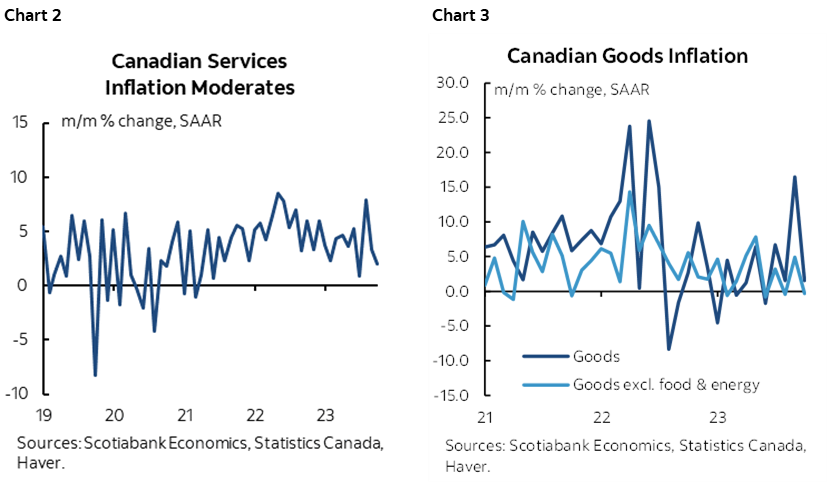
DETAILS
Charts 4–6 show that shelter cost inflation remains elevated particularly through rent. The lack of rental supply, purchase hesitancy and strong immigration likely explain this.
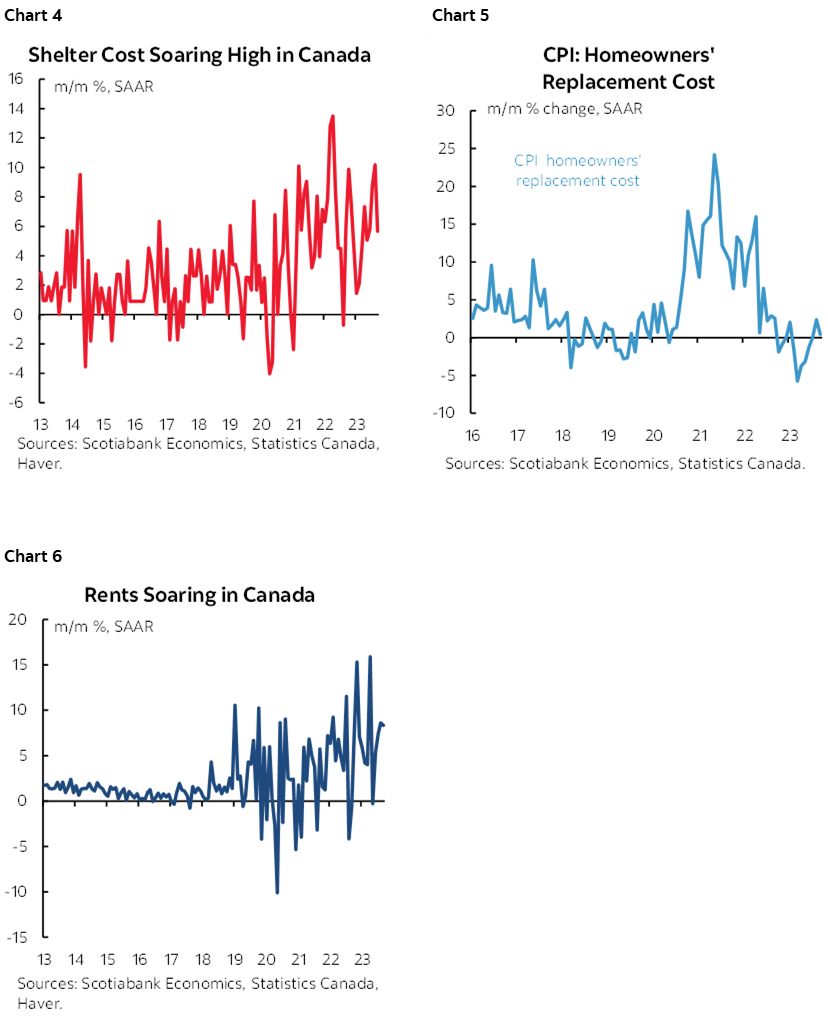
Transportation CPI eased as both vehicles and gasoline inflation pulled back (charts 7–9).
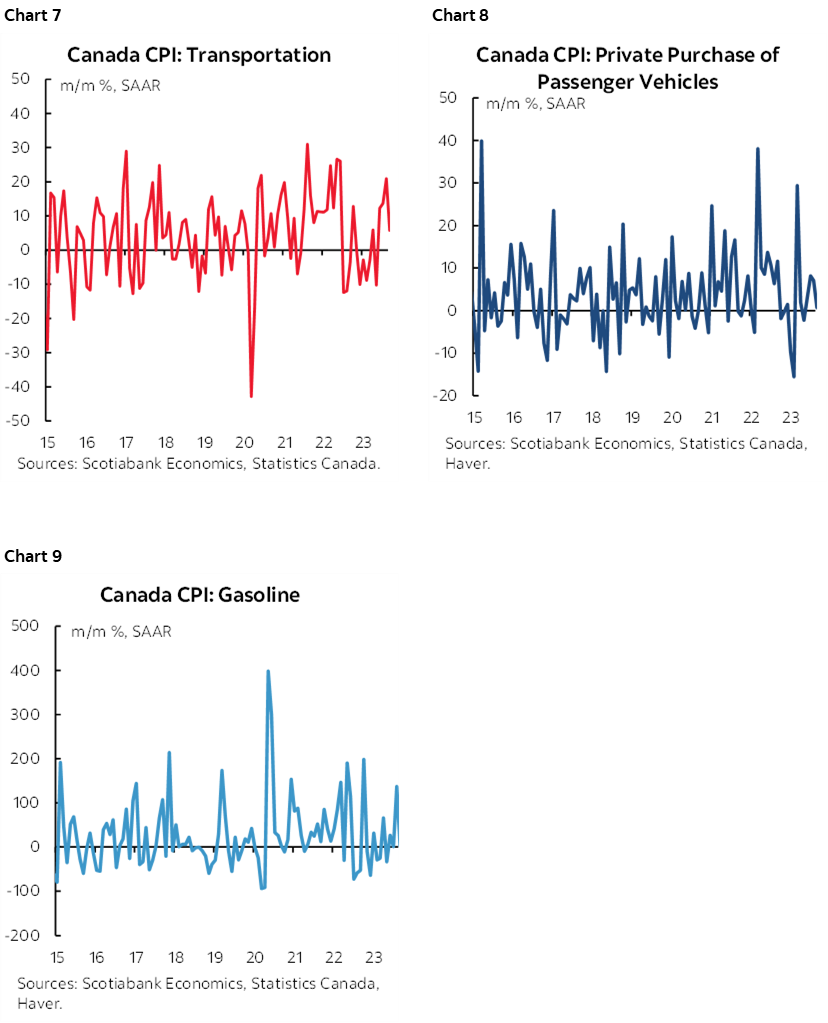
Some seasonal pressures were greater than usual including those affiliated with the new school year in the recreation, education and reading category of CPI (chart 10).
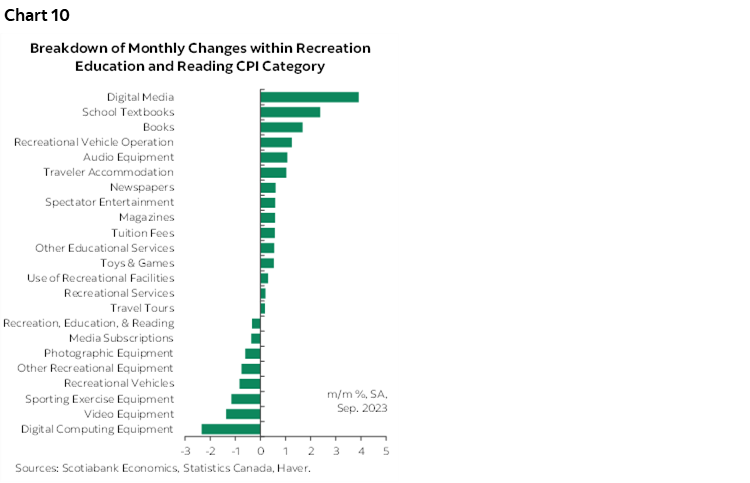
On revisions, apparently Statcan like's the number 0.6. A lot. It's all over the place in their revised trimmed mean and weighted median estimates going back in time. Chart 11 shows the difference between today's trimmed mean and weighted median m/m SAAR and the prior month's readings, by month back in time. It’s an ugly chart that looks like an ECG, but note the plethora of +/-0.6% SAAR revisions to the two measures over time in the latest set of readings versus prior batch of figures. This time the revisions knocked 0.6% m/m SAAR off both of the trimmed mean and weighted median measures; we’ll see next time.
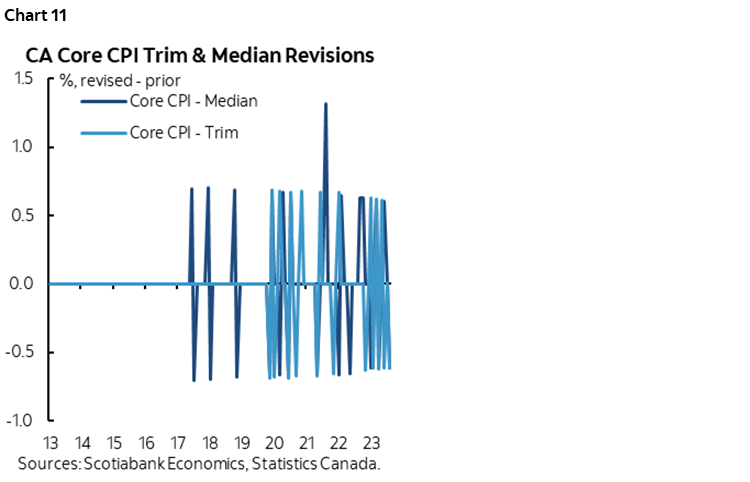
For further details, please see charts 12–13 for m/m changes across the CPI basket in unweighted and weighted contribution terms. Charts 14–15 do likewise for the y/y changes.
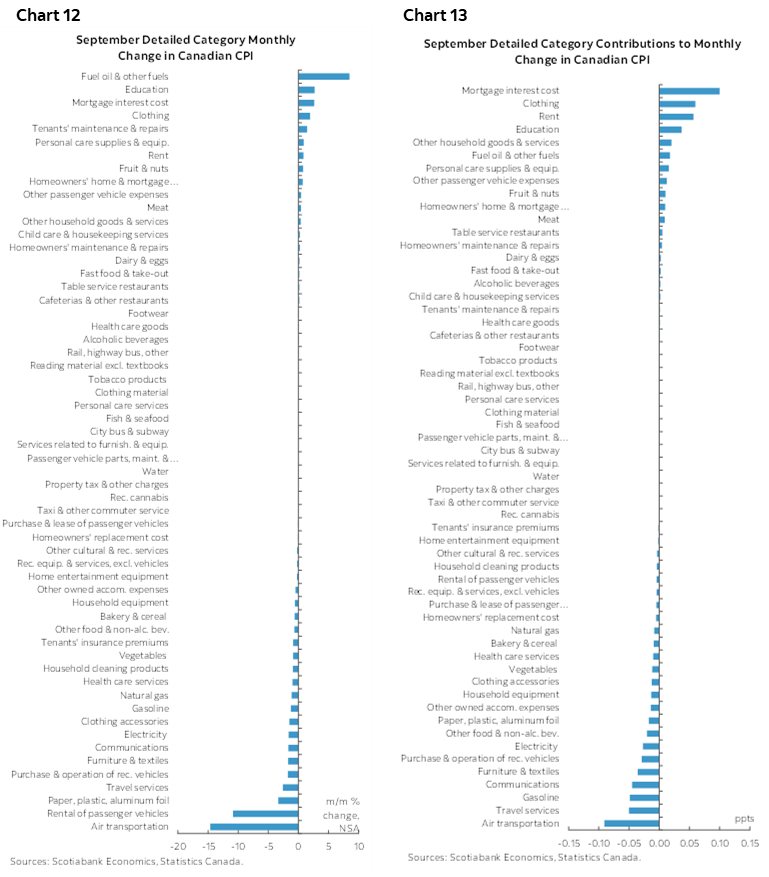
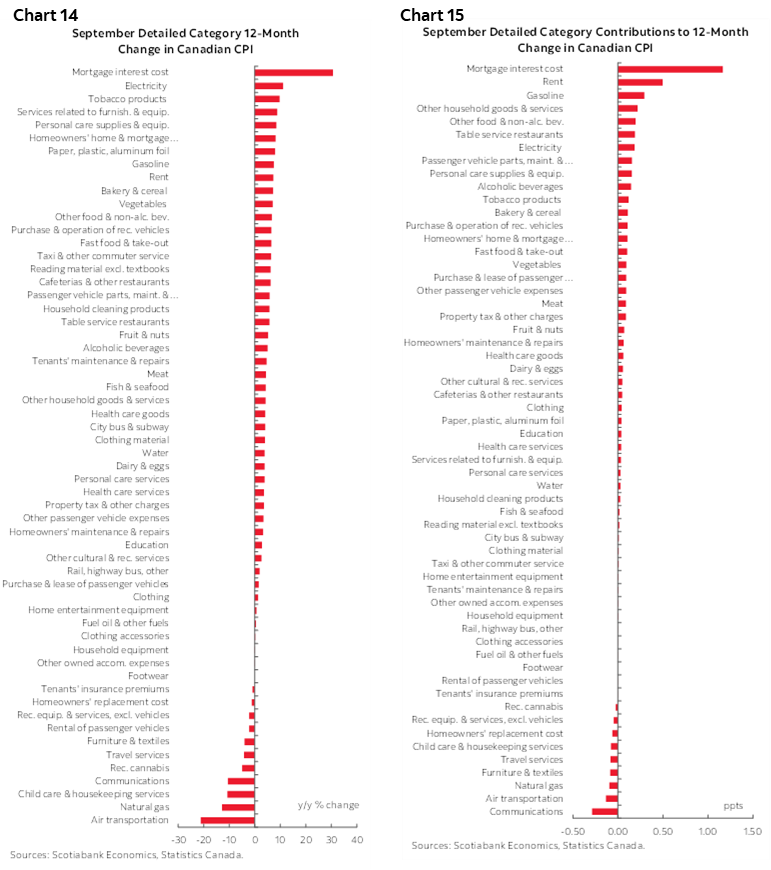
Please also see the accompanying table that breaks down the CPI basket in greater detail including micro charts and z-score measures of deviations.
WHY THE BoC MUST STILL BE CAREFUL
The BoC cannot afford to let its guard down and court premature pricing of future easing and so I think markets are correct to retain significant probability of a hike at meetings beyond next week’s.
Trend inflation risk is still pointed very much higher in future in my opinion. They are behind the wage and price developments with unmoored inflation expectations that are changing behaviour as wage demands far exceed their inflation target amid tumbling productivity. Fiscal policy, the terms of trade, an undervalued CAD, excessive immigration, a solid US economy, lean housing and auto inventories, and a probably higher neutral rate that implies less restrictive policy than thought, all fan inflation risks to the upside. At the same time, reading summertime activity readings is plagued by difficulty in separating out transitory shocks from the lagging effects of rate hikes and I’m still of the belief that the BoC should not be overstating the role of rate hikes in driving this patch of data.
But they'll likely be opportunistic and point to the latest inflation reading, as Macklem intimated in his comments last week, while flagging—even if in exaggerated fashion—soft recent activity readings. Exaggerated because of the multitude of unusual shocks beyond the effects of higher rates, but they'll play that up as signs that tighter policy is working.
On the effects of rates, Macklem has said that higher bond yields are not a substitute for a higher policy rate. He’s also departing from the Fed narrative on the topic because of the shorter-duration of rate sensitivities in Canada which implies greater policy rate control over medium-term yields versus the Fed’s focus upon the 10-year Treasury yield that guides mortgages. I think Macklem has to be careful in not being overly confident that 5s have cheapened because they’ve listened to him. It could well be spurious and keyed off correlated developments across global bond markets including a mixture of longer- and shorter-lived drivers as argued in prior writings. If markets really are listening to central banks, then they are attaching much greater confidence in forward guidance than has merit given the track records of both the Fed and the BoC to date.
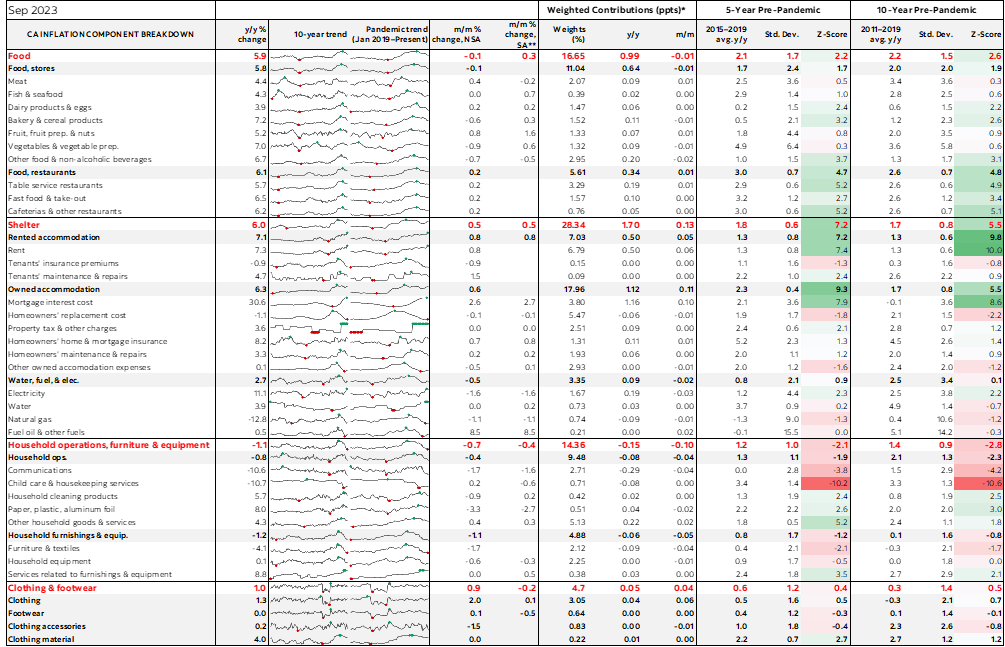
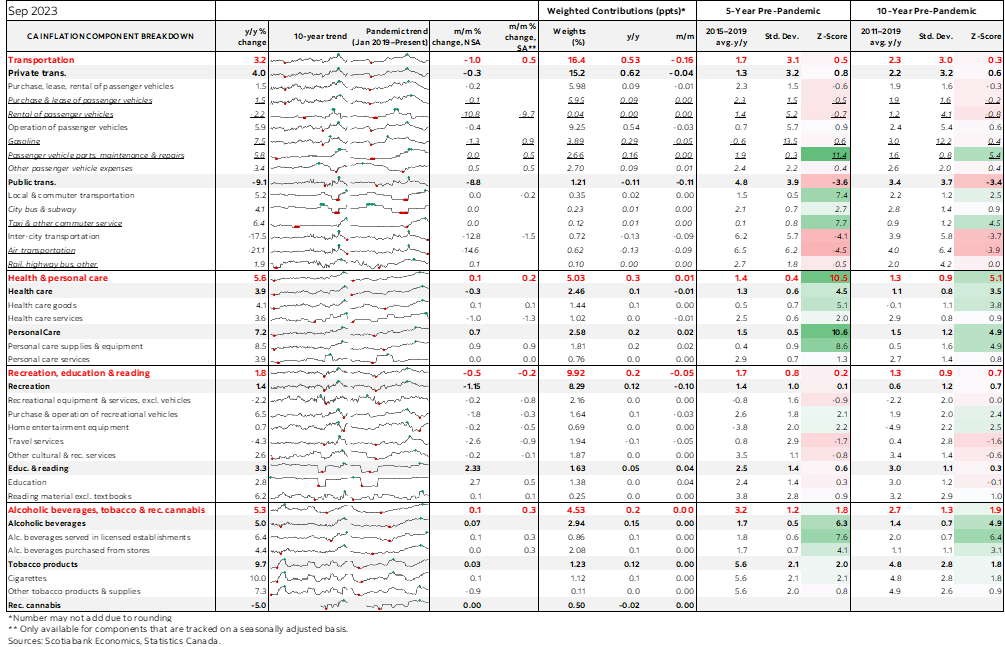
DISCLAIMER
This report has been prepared by Scotiabank Economics as a resource for the clients of Scotiabank. Opinions, estimates and projections contained herein are our own as of the date hereof and are subject to change without notice. The information and opinions contained herein have been compiled or arrived at from sources believed reliable but no representation or warranty, express or implied, is made as to their accuracy or completeness. Neither Scotiabank nor any of its officers, directors, partners, employees or affiliates accepts any liability whatsoever for any direct or consequential loss arising from any use of this report or its contents.
These reports are provided to you for informational purposes only. This report is not, and is not constructed as, an offer to sell or solicitation of any offer to buy any financial instrument, nor shall this report be construed as an opinion as to whether you should enter into any swap or trading strategy involving a swap or any other transaction. The information contained in this report is not intended to be, and does not constitute, a recommendation of a swap or trading strategy involving a swap within the meaning of U.S. Commodity Futures Trading Commission Regulation 23.434 and Appendix A thereto. This material is not intended to be individually tailored to your needs or characteristics and should not be viewed as a “call to action” or suggestion that you enter into a swap or trading strategy involving a swap or any other transaction. Scotiabank may engage in transactions in a manner inconsistent with the views discussed this report and may have positions, or be in the process of acquiring or disposing of positions, referred to in this report.
Scotiabank, its affiliates and any of their respective officers, directors and employees may from time to time take positions in currencies, act as managers, co-managers or underwriters of a public offering or act as principals or agents, deal in, own or act as market makers or advisors, brokers or commercial and/or investment bankers in relation to securities or related derivatives. As a result of these actions, Scotiabank may receive remuneration. All Scotiabank products and services are subject to the terms of applicable agreements and local regulations. Officers, directors and employees of Scotiabank and its affiliates may serve as directors of corporations.
Any securities discussed in this report may not be suitable for all investors. Scotiabank recommends that investors independently evaluate any issuer and security discussed in this report, and consult with any advisors they deem necessary prior to making any investment.
This report and all information, opinions and conclusions contained in it are protected by copyright. This information may not be reproduced without the prior express written consent of Scotiabank.
™ Trademark of The Bank of Nova Scotia. Used under license, where applicable.
Scotiabank, together with “Global Banking and Markets”, is a marketing name for the global corporate and investment banking and capital markets businesses of The Bank of Nova Scotia and certain of its affiliates in the countries where they operate, including; Scotiabank Europe plc; Scotiabank (Ireland) Designated Activity Company; Scotiabank Inverlat S.A., Institución de Banca Múltiple, Grupo Financiero Scotiabank Inverlat, Scotia Inverlat Casa de Bolsa, S.A. de C.V., Grupo Financiero Scotiabank Inverlat, Scotia Inverlat Derivados S.A. de C.V. – all members of the Scotiabank group and authorized users of the Scotiabank mark. The Bank of Nova Scotia is incorporated in Canada with limited liability and is authorised and regulated by the Office of the Superintendent of Financial Institutions Canada. The Bank of Nova Scotia is authorized by the UK Prudential Regulation Authority and is subject to regulation by the UK Financial Conduct Authority and limited regulation by the UK Prudential Regulation Authority. Details about the extent of The Bank of Nova Scotia's regulation by the UK Prudential Regulation Authority are available from us on request. Scotiabank Europe plc is authorized by the UK Prudential Regulation Authority and regulated by the UK Financial Conduct Authority and the UK Prudential Regulation Authority.
Scotiabank Inverlat, S.A., Scotia Inverlat Casa de Bolsa, S.A. de C.V, Grupo Financiero Scotiabank Inverlat, and Scotia Inverlat Derivados, S.A. de C.V., are each authorized and regulated by the Mexican financial authorities.
Not all products and services are offered in all jurisdictions. Services described are available in jurisdictions where permitted by law.

